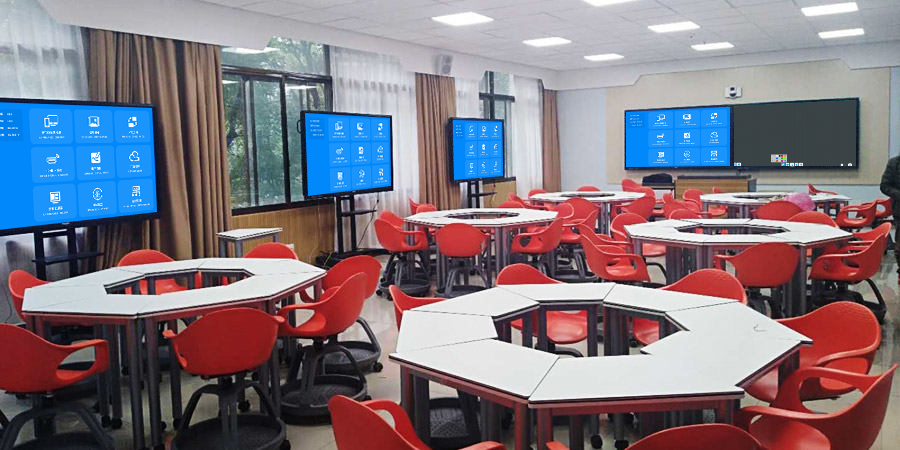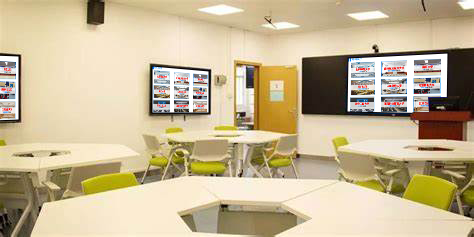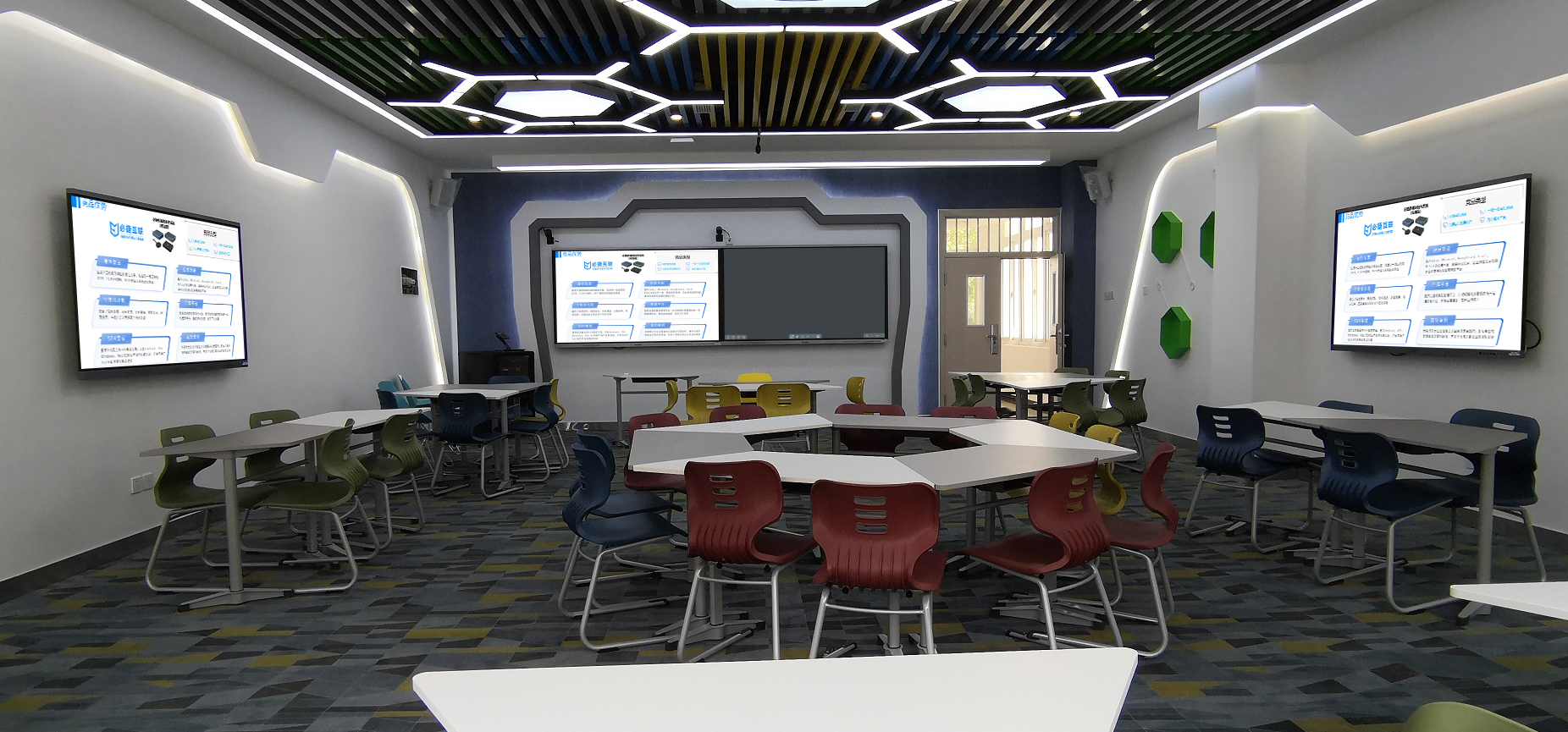Group Discussions: Allowing Every Group’s Wisdom to Shine
Group discussions, as an efficient collaboration model, often face pain points like “unsynchronized information, difficulty integrating results, and untraceable discussions.” A solution tailored for group scenarios can leverage device linkage, real-time interaction, and intelligent integration to visualize each group’s thought process and efficiently display their results, allowing collective intelligence to rapidly consolidate through collision.
I. Multi-Screen Linkage Architecture: Seamless Connection Between Groups and the Collective
(I) Star Network Connection
With the main screen as the core, each group is equipped with an independent sub-screen, forming a “1 main + 6 sub” star network. Within a group, phones, computers, and tablets can wirelessly mirror to the sub-screen, allowing members to share materials in real-time. For collective sharing, the sub-screen content can be “pushed to the main screen” with one click, enabling simultaneous viewing by the entire class or all participants, avoiding time wasted on taking turns at the front. When 6 groups are discussing concurrently, switching to display each group’s results on the main screen takes only 1.5 seconds, making comparative analysis more intuitive and discussions more streamlined.
(II) Cross-Group Content Interoperability
It supports bidirectional content pushing between sub-screens, allowing neighboring groups to reference each other’s ideas. In a corporate strategy discussion, the marketing team’s user research data can be pushed to the product team to help refine feature design. In a classroom case study, if the third group’s problem-solving framework is adopted by the second group, it can lead to an even more optimized solution, pushing brainstorming beyond group boundaries.
II. Real-Time Interactive Functions: Making Discussions “Traceable”
(I) Multi-User Collaborative Annotation
Sub-screens support 8 people simultaneously annotating with different colored pens. Members can circle key document points, add opinions, and modify logic. When a design team discusses a proposal in groups, the UI designer can mark visual issues in red, the product manager can add user requirements in blue, and the developer can note technical limitations in green. Multi-perspective opinions are superimposed on the same interface, avoiding the “easily forgotten oral discussion” problem and producing 2 times more effective ideas in 1 hour than traditional methods.
(II) Instant Polling and Summarization
Groups can initiate quick polls for questions like “Scheme A/B choice” or “priority ranking.” After members vote by scanning a QR code with their phones, the sub-screen generates a results chart in 3 seconds. In classroom group debates, group members vote to determine core arguments, and the voting process is synchronized to the main screen, allowing the teacher to observe each group’s decision-making tendencies in real-time and provide targeted guidance.
III. Result Integration and Presentation: From Fragmented to Systematized
(I) Intelligent Content Aggregation
The system automatically integrates mirrored documents, annotation traces, and voting results from within a group, generating a discussion report with a timeline. After a meeting, each group’s report can be compared in a split-screen view on the main screen, allowing decision-makers to clearly see each group’s thought process. After a classroom discussion, students reviewing their group report can precisely locate points of confusion, improving revision efficiency by 50%.
(II) Dynamic Display and Feedback
The main screen supports three modes: “split-screen comparison,” “carousel display,” and “highlight zoom.” For comparative analysis, the results of 6 groups can be presented side-by-side on the main screen for immediate clarity. When taking turns reporting, sub-screen content seamlessly switches to the center of the main screen, focusing everyone’s attention. When teachers or mentors provide feedback, they can use a stylus on the main screen to annotate the strengths and weaknesses of each group’s results, with annotations synchronizing back to the corresponding sub-screen for more precise feedback.
IV. Scenario-Based Implementation: Visible Efficiency Gains
(I) Classroom Discussion Scenarios
- Primary School Collaborative Learning: A 6-person group analyzes a fable, drawing a character relationship map on a tablet and mirroring it to the sub-screen. Members annotate personality traits with different colors. When pushed to the main screen, the teacher circles the creative highlights of each group, boosting classroom participation from 60% to 95%.
- Middle School Experimental Inquiry: Groups use their phones to record experiment processes, mirror them to the sub-screen to analyze operational details. After members annotate incorrect steps and push them to the main screen, the whole class compares different groups’ experimental methods, reducing the error rate by 65%.
(II) Enterprise Meeting Scenarios
- Departmental Group Discussions: Marketing, Sales, and Technology teams discuss product promotion plans separately. Sub-screens record modification tracks in real-time. After aggregation on the main screen, the CEO directly annotates optimization directions on the large display, shortening proposal finalization time by 40%.
- Cross-Departmental Collaboration: The R&D team and Operations team discuss new products from the perspectives of technical feasibility and market acceptance, respectively. After sub-screens share data, the main screen generates a SWOT analysis diagram, increasing consensus achievement efficiency by 35%.
(III) Training Workshop Scenarios
- Student Group Tasks: 6 groups of students complete case breakdowns. Sub-screen content synchronizes to the instructor’s terminal, who provides remote annotated guidance, allowing real-time control of each group’s progress. During result presentation, the main screen zooms in on a group’s key conclusions for in-depth discussion by all participants, improving training conversion rate by 50%.
The core value of group discussions lies in efficiently connecting “small-scale brainstorming” with “large-scale sharing.” It preserves in-depth thinking within groups while using technology to break down information barriers, allowing the wisdom of every group to become a cornerstone for collective progress, ultimately achieving a 1+1>2 collaborative efficiency.